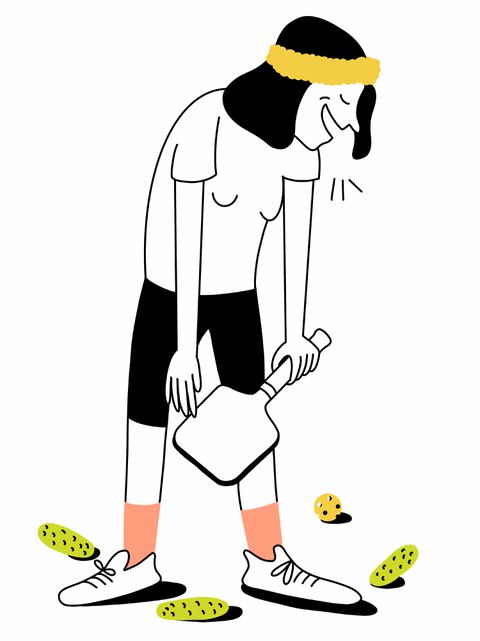10 self-care ideas to help you get through the pandemic into the fall
Nutrition
Soup up your meals
As the temperature drops, soup becomes a warming and healthy way to start a meal. But not just any soup — we’re talking about one brimming with vegetables and even some fruit, where every hardy slurp is filled with immune-supporting vitamins and minerals.
Only about 9 percent of Americans get enough vegetables daily, making soup a great menu addition. A high vegetable intake helps reduces the risk of heart disease, Type 2 diabetes and some cancers. While juicing has become a popular way to pound back fruit and veggies quickly, “souping” has two advantages. First, soup recipes tend to favor vegetables over fruit, making them lower in sugar. Second, while juicing eliminates the skin — and fiber — of fruit, soup-making uses whole fruits and vegetables, so soups are higher in fiber.
Autumn produce, such as kale, carrots, squash and apples, are perfect for soups. Basic recipes are easy: Drizzle oil in a pot and add aromatics, such as onion, shallots and garlic. Add two pounds of vegetables and four to six cups of water or stock. Simmer until vegetables soften, then add salt, herbs and spices to taste. If you prefer creamy soups, the blender is your next step.
Winning combinations include squash and apple; kale, tomato and white bean; and carrot with ginger. Fall offers endless opportunities to experiment. — Cara Rosenbloom

Make a better pumpkin spice latte
Pumpkin is loaded with vitamin A and makes a nutritious side dish, but it’s more often associated with seasonal indulgences, such as the love-it-or-hate-it pumpkin spice latte, or PSL.
At Starbucks, the PSL is the company’s top-selling seasonal drink. It’s made with milk, sugary syrup, pumpkin puree and spices, and clocks in at 380 calories and 50 grams (nearly 13 teaspoons) of sugar for a 16-ounce grande. In comparison, a four-piece Kit Kat bar has 210 calories and 22 grams (about 6 teaspoons) of sugar.
If you usually order regular coffee and add a teaspoon of sugar, switching to the pumpkin spice latte will add about 360 calories and 12 teaspoons of sugar. So, think of it as an occasional treat — like dessert — rather than something to order daily. If you do indulge often, customize the drink. Ask for it “half-sweet” to reduce the amount of sugar, or save calories by requesting nonfat or almond milk and no whipped cream. A half-sweet, almond milk, hold-the-whipped-cream PSL has about 180 calories.
You can also make a fantastic latte flavored with pumpkin and spices at home. Simply blend coffee and your favorite milk with 2 to 3 tablespoons of canned pumpkin puree and a teaspoon or two of sugar. Sprinkle with pumpkin pie spices: The Starbucks recipe favors cinnamon, ginger, nutmeg and clove. — Cara Rosenbloom
Fitness
Go for a walk — with Nordic poles
Part walking and part cross-country skiing, Nordic pole walking is an exercise well suited for outdoors in the fall. Combining low-impact cardio with an upper-body strength workout, it takes conventional fitness walking to a new level.
“With the activation of stomach, back and arm muscles every time you push through the pole, NPW becomes a full-body workout,” says Jennifer Howey, a master instructor and owner of InsideOut Physiotherapy in Toronto, who offers instructional videos on her website. “It is an excellent cross-trainer and rehabilitation tool.” It’s also fairly affordable; your only outlay is the poles, which run from $35 to $100.
Not only can Nordic pole walking be done with social distancing, it can address some of our pandemic woes. “People are suffering with neck and low-back issues from sitting for extended periods of time,” Howey says. “Nordic pole walking works to correct posture and strengthen posture muscles.”
Judith Klau, 85, of Boston, who is a friend and avid pole walker, has taken her poles out even more frequently since the onset of the pandemic. “I am walking twice a week now,” she says. “I don’t worry about my balance, because the poles anchor me.” This extra benefit makes Nordic pole walking one of the few sports that truly can be done by almost anyone. — Lorne David Opler

Sweat it out with pickleball
As a kid, I bonded with my grandmother over word games, never athletics. Sadly, we hadn’t heard of pickleball.
If you’re picturing nothing but sweet or sour cucumbers, you may soon be in the minority. Pickleball, which celebrates its 55th anniversary this year, is one of America’s fastest-growing sports; an industry association reported 3.3 million players in 2019, up about 29 percent from 2015.
Think a combination of ping-pong — paddles swatting a plastic ball — and tennis, but with a lower net, a court one-fourth the size and players a few decades older than Roger Federer. Pickleball, usually played as doubles, involves less running than other sports; it has been called a “two-step game,” which makes it good for seniors who may have limited mobility. But it’s gaining popularity among younger folks. (Singles can be a fairly safe pandemic choice for people not isolating together because players are separated by a 14-foot non-volley zone; opponents can use different-colored balls.)
The multigenerational appeal makes pickleball a good choice for families. The United States has more than 15,000 dedicated courts, but you can create a pop-up court on any paved surface. There, adults avoiding gyms can gather with kids missing PE and sports. Give the iPad and Scrabble a break and head outside for a pickleball showdown with Grandma. — Matt Fuchs
Home
Bring the outdoors in …
Making a home cozy for fall can be as simple as gathering pine cones in a centerpiece bowl. For something different this year, Hannah Morgan, owner of the Seattle-based botanical studio and garden Fortunate Orchard suggests using wire to attach pine cones to branches for vases. “The beauty of using pine cones or branches is that they don’t need water,” she explains. Make different heights of these pine-cone sticks for the vase and mix them with dried grasses or botanicals. “A lot of time for me,” she explains, “the gathering of all of these things is the best part, and the most important part, especially right now when we’re stressed out.” Take a walk early in the fall (when it’s dry out) and look for grasses, cones and seed pods that have fallen. For an arrangement that will evolve into winter, Morgan suggests making a garland, stringing pine cones and grasses with twine and ribbon, to be laid flat on a dining table or hung from a mantle. Add some dried leaves when they fall. Come Thanksgiving, you can add decorative squash, and in winter, evergreen branches. “It’s a nice rotating exhibit in your living space,” Morgan says. Because the base of these arrangements doesn’t need water, they will last throughout the season. — Lindsey M. Roberts

… Or make yourself at home outside
As we begin to escape summer’s sizzle and face the responsibilities of fall, making good use of your home’s outdoor spaces might just be what keeps you sane, New York interior designer Hilary Matt says. She recommends starting with a furniture arrangement that works for all seasons. For a balcony, that can be a weather-resistant bistro set. For a patio, a dining table and chairs are great for cookouts or messy pumpkin carving come October. String lights or tiki torches can add a festive touch.
Stow heavy blankets, such as wool ones, in baskets away from the elements, or splurge on a heat lamp to ensure that you can enjoy your outdoor space into the night ― and as the evenings grow colder. S’mores, anyone? “One of the best things that people can do in their backyard when it’s cold out is add a firepit,” Matt says. “It’s a good way to social distance because you can have people over but sit far apart.” — Lindsey M. Roberts
Human connection
Lend a helping hand
One of the best ways we can volunteer our time right now is simply loving our neighbor. We can run errands for the elderly, bring meals to friends out of work and make a better effort to talk to relatives on the phone. This is also a great time for families to come together and bond over serving others, says David Thomas, the director of family counseling at Daystar Counseling in Nashville. “There are many opportunities for families to give and serve on a national level during the pandemic,” he explains. “My challenge to families is to look for local opportunities to serve as well.” Besides picking up groceries or medication, he suggests baking for neighbors, decorating driveways with encouraging messages in sidewalk chalk, and offering to walk dogs or pick up school supplies.
Bringing kids, especially teenagers, in on the brainstorming will help develop their awareness and empathy. Teenagers can plan care packages for classmates headed to college, collect and package canned foods for food banks and write notes to health-care providers at a hard-hit hospital. “We’ve all felt helpless and hopeless in different moments of this global pandemic,” Thomas says. “Modeling for kids how to take those emotions to something constructive is not only helpful for this moment, it’s a valuable life skill for the future.” — Lindsey M. Roberts

Prioritize meaningful relationships
Loneliness has surely hit us all this year. “Virtual is wonderful, but I think we’re all wanting to talk in person,” says Kim Grevler, a clinical social worker and life coach in New York. What if, though, this were an ideal time to step back and evaluate the relationships in our lives? Ask yourself, she says, if you get together with certain people only out of obligation. “Are we settling for some friendships and relationships?” she asks. This may sound harsh, but it doesn’t have to be. It could simply mean that, for example, even though you like your book club friends, you want to prioritize time elsewhere. Maybe that’s more time taking care of your parents or intentional time with your kids.
The prompt Grevler gives her clients is: “If I were honest with myself … .” If you were honest with yourself, who do you want to spend time with right now? Which groups would you quit? Which would you join? Do you wish you had a circle for your favorite hobby? Get the people you want down on your calendar, and then evaluate your flexibility. Don’t be afraid to see people, even six feet apart, especially if it’s outdoors. It will take time to push past the fear. Grevler says that if you’re feeling uncomfortable, the other person is probably feeling uncomfortable, too. “If you’re feeling lonely and unsettled, don’t blame yourself for that, and shun yourself,” she explains. “Use it as ammo to connect more with other people.” — Lindsey M. Roberts
Mindfulness
Take a deep breath (or five)
Deep breathing is a great way to calm down. But taking a deep breath is not easy to do when we are stressed, because anxiety often manifests as tightness in the throat and jaw. That’s why you can often hear stress in someone’s voice. Before we can start taking deep breaths, then, we have to open the vocal cords.
To do that, take three to five continuous sniffs of air through your nose, as if you are smelling a fragrant flower. Then, exhale a long slow breath out of your mouth with rounded lips.
Next, without engaging your shoulders and chest, try taking a deep breath through your nose all the way into your lower lungs or belly. Put your hands on your belly to feel your stomach rising. If necessary, repeat the sniffs until you can take that deep breath.
When we’re stressed, we primarily use our mouth to breathe into the upper lungs. Breathing into our lower lungs, on the other hand, stimulates the vagus nerve, which in turn activates a relaxation response (decreasing your heart rate and blood pressure). It also allows the lungs to distribute more oxygen throughout the body, enhancing the calming effect. — Amanda McCracken

Get hooked on crochet
Knitters have a tendency to look down on crochet, the latter being, technically, a less difficult art. Those of us who love crochet respond with a shrug. “Whatever,” we say, as we launch into some wild variation on a pattern, making up the rules as we go and reveling in a magical flow between mind and body that, yoga-like, instills calm while strengthening the inner core of one’s being.
Crochet is a gorgeously forgiving medium, allowing the freedom to explore without having to worry about the dreaded “dropping” of stitches that strikes fear in the hearts of novice knitters. Where knitting is for “experts,” crochet is for everyone, and I could teach you, dear reader, in 10 minutes, as I have taught others countless times.
Yet this simple craft, along with a basic algorithmic pattern, can be used to generate complex curving “hyperbolic” surfaces that mimic the shapes of coral. For 15 years, my twin sister, Christine, and I, joined by thousands of women worldwide, have been working on the Crochet Coral Reef, a global art and science project we created. Together we’ve whiled away countless hours making sculptural forms with our hooks as we binge-watch “Xena: Warrior Princess” and other outré feminist delights. “I didn’t waste an evening,” I can say. “Look what a fantastic form I created!” — Margaret Wertheim
Matt Fuchs lives in Silver Spring, Md., and writes about health and culture.
Amanda McCracken is a writer and massage therapist based in Colorado.
Lorne David Opler is a Nordic pole walking instructor and personal trainer in Toronto.
Lindsey M. Roberts is a writer based in North Carolina.
Cara Rosenbloom is a registered dietitian, writer and president of Words to Eat By.
Margaret Wertheim is a science writer and artist.
Design by Christian Font.






